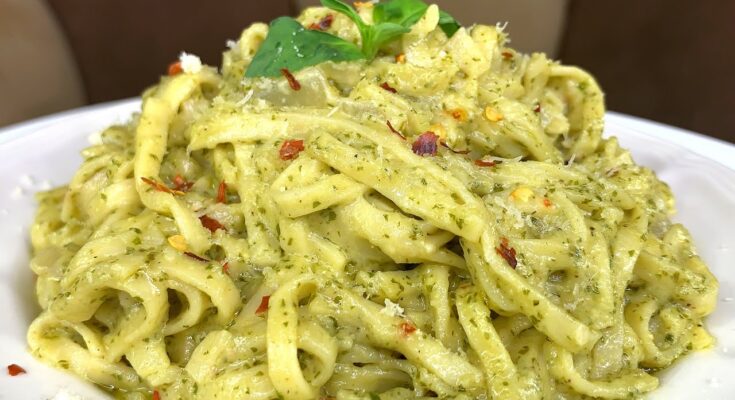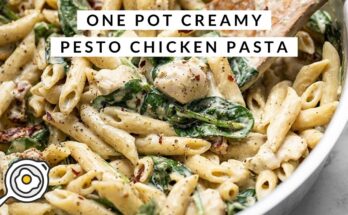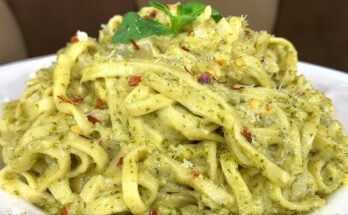Creamy Pesto Sauce Recipe: Pesto on its own is already a green goddess of flavor — fresh basil, rich olive oil, earthy pine nuts, sharp Parmesan, and garlic punching through the greenery like a flavor ninja. But when you add cream to the mix? Game-changer. That’s where the magic of creamy pesto sauce comes in. It transforms the bright, punchy profile of classic pesto into something rich, luxurious, and melt-in-your-mouth delicious. It’s like turning a fiery little Italian sports car into a Rolls Royce—same power, smoother ride.
The creamy texture doesn’t just look fancy—it also clings better to pasta, spreads more evenly over chicken or shrimp, and gives you that decadent “just one more bite” factor. Whether you’re whipping up a quick weeknight dinner or trying to impress your date with a plate that screams “I know what I’m doing in the kitchen”, creamy pesto sauce is your secret weapon.
Traditional vs. Creamy Pesto: What’s the Difference?
Classic pesto is raw, vibrant, and pretty oily — designed to be stirred through hot pasta, used as a marinade, or spooned over bread. But creamy pesto sauce adds a whole new layer of indulgence. It incorporates heavy cream (or alternatives like half-and-half, cream cheese, or even Greek yogurt), transforming it into a luscious, sauce-like consistency that holds up beautifully in warm dishes.
This version doesn’t just taste different — it behaves differently, too. Cream tames the sharpness of garlic and basil, rounds out the edges, and creates a more cohesive flavor profile. It also stretches the sauce further, which means you can feed more mouths without sacrificing flavor. And yeah, it looks fancier. Instagram, here we come.
List of Ingredients You’ll Need
Classic Core Ingredients
Here’s the heart and soul of your creamy pesto sauce. No need for culinary wizardry — just fresh, real ingredients.
- Fresh Basil Leaves (2 cups packed): The star of the show. Bright, fragrant, and green as envy.
- Garlic Cloves (2-3): Bold and unapologetic, like a good espresso.
- Pine Nuts (1/4 cup): Buttery and rich; toast them for extra flavor.
- Parmesan Cheese (1/2 cup grated): Sharp, salty, and oh-so-Italian.
- Olive Oil (1/2 cup): Smooth and golden. Extra virgin preferred.
- Heavy Cream (1/2 cup): The creamy element that gives this sauce its velvety finish.
- Salt and Black Pepper (to taste): Don’t skip this—flavor needs balance.
Optional Add-ins for Extra Flavor
Want to remix it a little? No rules, just vibes.
- Spinach: Adds a nutritional punch and brightens the color.
- Lemon Juice or Zest: For a zippy twist.
- Crushed Red Pepper Flakes: If you like a little heat.
- Cream Cheese: For an even thicker, tangier result.
- Greek Yogurt: Healthier twist with a slight tang.
These are your bonus tracks — optional, but worth exploring if you’re feeling creative.
Kitchen Tools Required
Must-Have Equipment
- Food Processor or Blender: Non-negotiable. It’s the engine room of this operation.
- Measuring Cups and Spoons: Because precision matters.
- Knife and Cutting Board: For prepping your ingredients.
Nice-to-Haves That Make Life Easier
- Microplane/Zester: Great for finely grating Parmesan or zesting lemons.
- Spatula: Helps scrape every last drop of green gold.
- Small Pan: If you want to lightly toast pine nuts (pro tip: you should).
Step-by-Step Guide to Making Creamy Pesto Sauce
1. Prep Your Ingredients
Start with fresh basil — not the wilted stuff hiding in the back of your fridge. Rinse it under cold water, pat dry gently (nobody likes watery pesto), and pluck the leaves off the stems.
Peel the garlic cloves. Measure out your pine nuts and cheese. If you’re using extras like spinach or lemon, prep those now.
2. Toast the Pine Nuts (Optional but Recommended)
In a dry pan over medium heat, toss your pine nuts until golden and fragrant — around 3–4 minutes. Watch closely. They can go from toasty to burnt faster than your ex ghosting your texts.
Toasting = richer, nuttier flavor. It’s the chef’s kiss of the pesto world.
3. Blend the Base Pesto
Into the blender or food processor, toss in:
- Basil leaves
- Garlic
- Pine nuts
- Parmesan
- Salt and pepper
Pulse until everything’s chopped down but still rough. You’re not looking for a puree just yet — think chunky salsa consistency.
Then, with the processor running, drizzle in olive oil slowly until the mixture emulsifies into a paste. It should look like a vibrant green spreadable paste with a bit of texture.
4. Add the Cream and Blend Again
Now, pour in the heavy cream and blend again until smooth and velvety. Taste as you go. Want it cheesier? Add more Parm. Want it thinner? More cream or a splash of milk.
You’re aiming for a texture that’s thick enough to coat pasta but still pourable. Not gloopy, not runny. Think Alfredo meets pesto, but they went to culinary school in Tuscany.
5. Final Taste Test and Adjustments
This is the remix phase. Add lemon juice if you need acidity. More salt if it tastes flat. A pinch of red pepper flakes if you like danger. Make it yours.
Then — boom. You’ve got creamy pesto sauce ready to rock.
Best Tips for a Smooth, Velvety Texture
Achieving that ultra-silky, restaurant-quality texture in your creamy pesto sauce isn’t just about ingredients—it’s also about technique. Even the best components can go sideways if you’re not paying attention to the details.
Choosing the Right Cream
Not all creams are created equal. For that dreamy, rich mouthfeel, heavy cream (also labeled as heavy whipping cream) is the gold standard. It contains about 36-40% fat, which gives your pesto a luxurious body without being too thin or watery.
If you’re trying to be a little lighter (but not too light), half-and-half can do the trick. Just know it won’t be as thick or rich. Avoid milk—it simply won’t give you the same lusciousness and might separate when heated.
Pro Tip: Want to go next level? Add a dollop of mascarpone or a spoonful of cream cheese for a creamy, tangy twist that also thickens your sauce beautifully.
Preventing Separation
You know what ruins a good pesto moment? A broken sauce. That’s when the oil and cream decide to break up and go their separate ways on your plate. Sad.
To avoid this:
- Blend slowly and steadily: Add oil in a slow stream when blending your base. Emulsification is the name of the game.
- Don’t overheat the sauce: If you’re heating it, keep it on low. High heat = separation. This sauce likes it warm, not boiling hot.
- Stir before serving: Cream and oil can separate a little when sitting. A quick stir brings everything back together like a team huddle.
Texture can make or break the whole experience. Follow these tips, and your sauce will glide like silk over everything it touches.
Storage Tips and Shelf Life
One of the best things about creamy pesto sauce? It keeps like a dream (well, mostly). Whether you’re meal prepping or just saving leftovers, how you store it can make all the difference.
How to Store Your Creamy Pesto
Transfer your pesto to an airtight glass container. Press a piece of plastic wrap directly against the surface before sealing the lid. This helps prevent oxidation (aka the nasty browning).
- Fridge Life: 3–5 days max. Any longer, and it starts to lose that fresh pop of flavor and color.
- Reheat Gently: Warm it slowly on low heat. Stir often and don’t boil it—remember, we’re avoiding curdling or separation.
Can You Freeze It?
Heck yes, you can freeze creamy pesto. Here’s how to do it like a pro:
- Freeze in small portions: Use ice cube trays or silicone molds. Once frozen, transfer cubes into a freezer-safe bag.
- Thaw overnight: Or reheat from frozen on the stove—just use low heat and stir constantly.
Heads up: The texture might be slightly grainier after thawing due to the cream. A splash of fresh cream and a quick blitz in the blender can bring it back to life.
How to Customize Your Creamy Pesto Sauce
This sauce is ridiculously versatile. It’s like the little black dress of the kitchen—classic, flattering, and begging to be styled your way.Vegan/Dairy-Free Version
Want all the flavor without the dairy? No prob.
- Cream substitute: Use unsweetened oat milk, almond milk, or coconut cream.
- Cheese substitute: Nutritional yeast gives you that nutty, cheesy vibe.
- Skip the cream cheese or mascarpone unless you have vegan versions on hand.
Pro move: Blend in some soaked cashews for body and richness—it’s like creamy pesto sorcery.
Nut-Free Version
Pine nuts too pricey or allergy-triggering? Sub them out!
- Sunflower seeds
- Pumpkin seeds
- Hemp hearts
Still buttery, still creamy, still 10/10.
Spicy Twist
Bring the heat.
- Add a fresh chili pepper to the blender.
- Sprinkle in cayenne or red pepper flakes.
- A dash of hot sauce never hurt anyone (okay, maybe it did, but it was worth it).
Experiment and find your signature spin—there’s no pesto police watching.
What to Serve with Creamy Pesto Sauce
This sauce isn’t just a one-trick pasta pony. It’s versatile, baby. Like, roll-out-the-red-carpet versatile. Let’s talk about all the ways you can let it shine.
Pasta Pairings
Obvious? Maybe. Essential? Definitely.
- Fettuccine or linguine: The flat strands catch the sauce like a net.
- Gnocchi: Little pillows of potato love + creamy pesto = comfort food royalty.
- Penne or rigatoni: Those ridges are sauce magnets.
Want to make it extra? Toss in grilled chicken, roasted cherry tomatoes, or sautéed mushrooms for a full meal deal.
Proteins That Love Pesto
Creamy pesto isn’t just for carbs—it’s a meat magnet.
- Grilled chicken: Slice it and drizzle the sauce over top.
- Shrimp: Quick sauté and toss with pesto. Dinner in 10.
- Salmon: Brush pesto on before or after baking—flavor bomb.
Vegetarian Options
Plant-based foodies, this sauce has your back.
- Roasted vegetables: Cauliflower, zucchini, asparagus—coat ’em in pesto and go wild.
- Stuffed bell peppers: Mix pesto into your rice or quinoa stuffing.
- Pizza: Swap out red sauce for creamy pesto and thank me later.
Creamy Pesto Pasta Recipe (Bonus!)
This one’s for those days when you want something stupid easy but still wildly delicious.
Quick Pasta Toss Method
- Boil 1 lb of pasta until al dente. Reserve ½ cup pasta water.
- In a pan, warm 1 cup creamy pesto sauce over low heat.
- Add the cooked pasta and a splash of pasta water. Toss to coat.
- Serve with a sprinkle of Parmesan and cracked pepper.
Add-Ins for a Full Meal
- Grilled chicken or sausage
- Roasted cherry tomatoes
- Spinach or arugula
- Toasted breadcrumbs for crunch
It’s a 20-minute masterpiece you’ll make on repeat.
Common Mistakes to Avoid
Even though creamy pesto sauce is pretty forgiving, a few rookie errors can take your sauce from gourmet to meh real fast. So let’s break down what not to do if you want your pesto to live its best life.
Overheating the Sauce
This is the number one sauce killer.
Cream doesn’t like high heat. Ever tried boiling Alfredo sauce? Yeah, it curdles, separates, and turns into a sad, grainy mess. The same rules apply here.
The Fix:
- Warm your sauce on low heat, slowly and gently.
- If you’re tossing it with pasta, do it off the heat and use some reserved pasta water to loosen things up.
- If reheating, stir constantly and remove from heat at the first sign of boiling.
Using Old Basil or Garlic
Pesto lives and dies by the quality of its ingredients. Wilted basil tastes dull and bitter. Old garlic? That gives your pesto a sharp, almost metallic bite. Not exactly what you want.
The Fix:
- Always use fresh basil—bright green, no black spots.
- Stick to young, firm garlic. If it’s sprouting or smells funky, toss it.
Skipping the Taste Test
Everyone’s palate is different. If you don’t taste as you go, you might end up with something too salty, too bland, or just not right.
The Fix:
- After blending your base pesto, give it a try before adding cream.
- Taste again once the cream is in. Adjust salt, lemon, cheese—whatever it needs.
Cooking is jazz, not classical. Improvise a little.
Using Pre-Shredded Cheese
Yeah, it’s convenient. But those pre-shredded bags often come coated in anti-caking agents, which mess with the sauce texture.
The Fix:
- Buy a wedge of Parmesan or Pecorino Romano and grate it fresh. The flavor is sharper, the texture melts better, and your sauce will thank you.
Nutrition Breakdown
Let’s be honest—creamy pesto sauce isn’t winning any “light and fit” awards. But it is packed with real, whole ingredients that fuel your body and feed your soul. Here’s a rough estimate per 1/4 cup serving.
| Nutrient | Amount |
|---|---|
| Calories | ~250 |
| Total Fat | 24g |
| Saturated Fat | 8g |
| Protein | 4g |
| Carbohydrates | 2g |
| Fiber | 0.5g |
| Sugar | <1g |
| Sodium | ~200mg |
Healthy or Hearty?
Honestly? It’s both.
You’ve got healthy fats from olive oil and pine nuts, antioxidants from basil, and calcium from Parmesan. But yes, there’s cream. And yes, it’s rich.
Pro Tips:
- Want it lighter? Use Greek yogurt or light cream instead.
- Use it as a flavor enhancer, not the main dish—unless it’s pasta night, then go nuts.
Serving Sizes and Scaling the Recipe
Creamy pesto sauce isn’t just for feeding your roommates on pasta night—it scales up or down depending on what you need.
Cooking for One
- Use half the ingredient amounts.
- Store leftovers in ice cube trays for easy future meals.
- One cube = perfect for one bowl of pasta or a single chicken breast.
Feeding a Crowd
- Double (or triple!) the recipe if you’re hosting.
- Make it the day before—flavors deepen overnight.
- Keep warm in a slow cooker or on the stove at very low heat.
Just remember: one batch of this sauce covers about 1 lb of pasta generously. Multiply accordingly.
Creative Uses for Leftover Pesto
You made a big ol’ jar of creamy pesto and now you’re wondering what else to do with it besides pasta. Here’s where things get interesting.
1. Sandwich Spread
Use it as a mayo replacement in sandwiches and wraps. It turns a basic turkey sammie into a gourmet lunch. Toasted bread + pesto + tomato + mozzarella = mind blown.
2. Pizza Base
Ditch the marinara. Slather creamy pesto on pizza dough, top with mozzarella, and add grilled chicken or roasted veggies. It’s like flatbread, but way better.
3. Salad Dressing
Thin it out with a little lemon juice and olive oil. Boom—creamy, herby dressing that makes salads actually enjoyable.
4. Dip for Bread or Veggies
Warm it up slightly and serve with crusty bread, pita, or even carrot sticks. It’s like hummus’s fancy cousin.
5. Baked into Casseroles or Lasagna
Layer it between sheets of pasta or dollop it into baked ziti. Creamy pesto + melted cheese = comfort food on steroids.
Pairing Suggestions
You’ve got your sauce. Now let’s dress it up and complete the vibe.
Wine and Drinks
- White Wine: Sauvignon Blanc or Pinot Grigio balances the creaminess with crisp acidity.
- Red Wine: Light-bodied reds like Pinot Noir won’t overpower the basil.
- Sparkling Water with Lemon: If you’re sober-curious or just chilling, this keeps things fresh.
Side Dishes That Work Best
- Garlic Bread: Duh.
- Caprese Salad: Mozzarella, tomatoes, basil—it complements the pesto like a soulmate.
- Roasted Veggies: Keep it simple with asparagus, zucchini, or bell peppers.
- Antipasto Platter: Meats, olives, artichokes—it’s an Italian feast.
Whether it’s dinner for one or a full-blown dinner party, creamy pesto sauce makes everything feel a little more elevated.
FAQs about Creamy Pesto Sauce Recipe
1. Can I use milk instead of cream?
Technically yes, but your sauce will be thinner and might separate more easily. For better results, go with half-and-half or stir in a touch of cream cheese for body.
2. How long does creamy pesto last in the fridge?
Stored in an airtight container, it stays good for about 3–5 days. Add a layer of olive oil on top or press plastic wrap against the surface to prevent browning.
3. What can I use instead of pine nuts?
Plenty of tasty alternatives:
- Walnuts
- Cashews
- Sunflower seeds (for nut-free)
- Almonds (blanched)
Toasting them first adds even more flavor.
4. Can I make it without a blender?
Yes, but it’s more labor-intensive. Use a mortar and pestle or finely chop everything by hand. It won’t be as smooth, but it’ll still taste incredible (and rustic!).
5. Is creamy pesto sauce gluten-free?
Yes, the sauce itself is naturally gluten-free. Just make sure any add-ins (like pasta) are certified GF if needed.
Conclusion
Creamy pesto sauce is one of those rare kitchen wins that delivers on all fronts—flavor, texture, and versatility. It’s bold and rich without being over-the-top. It’s fancy enough for guests but easy enough for a Tuesday night. And once you master it? You’ll never go back to the jarred stuff again.
Whether you spoon it over pasta, swirl it into soups, or slather it onto your next grilled sandwich, this sauce is destined to be a kitchen staple. So get those basil leaves ready, blend with love, and make a batch today. Your taste buds will throw a parade in your honor.



